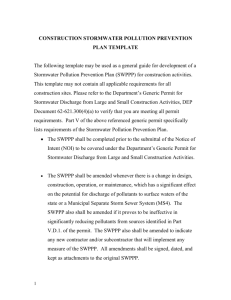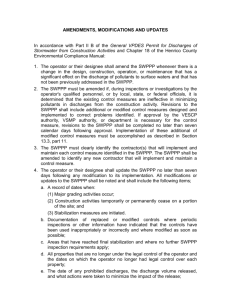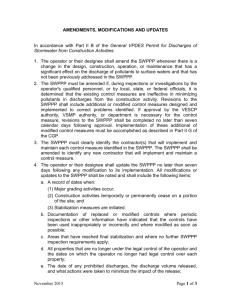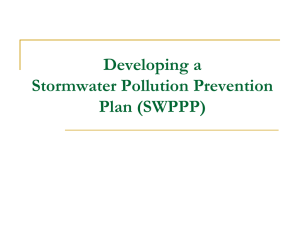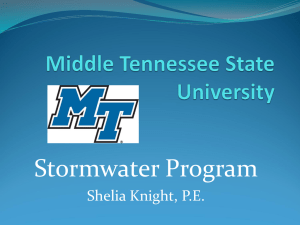Industrial Stormwater Pollution Prevention Plan Template
advertisement
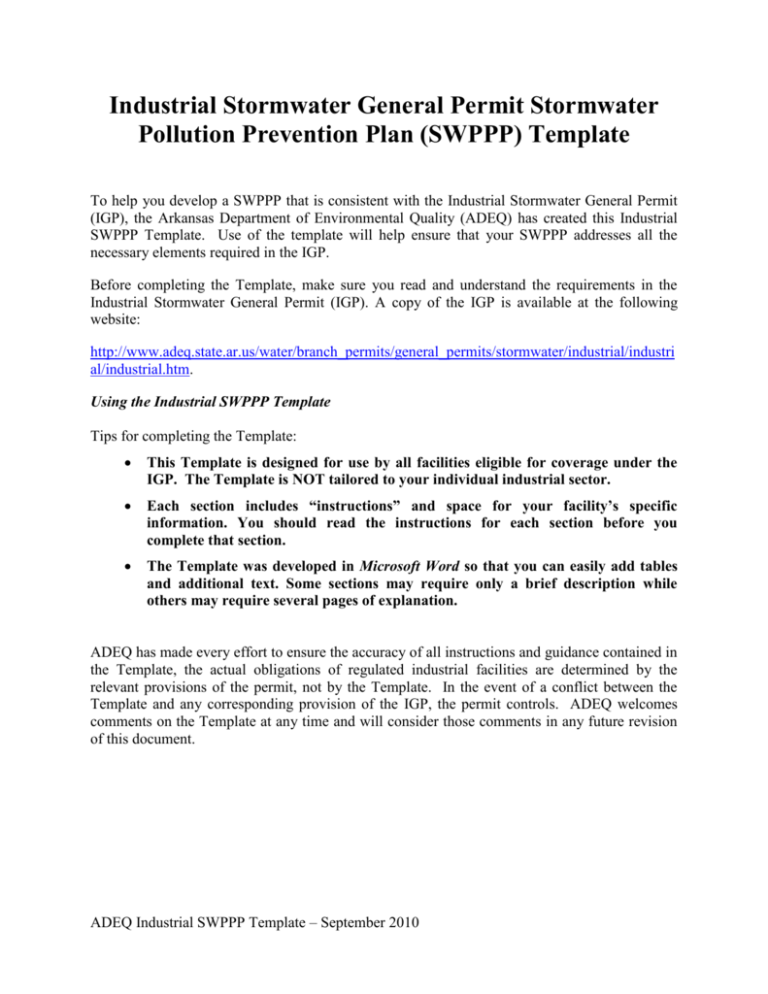
Industrial Stormwater General Permit Stormwater Pollution Prevention Plan (SWPPP) Template To help you develop a SWPPP that is consistent with the Industrial Stormwater General Permit (IGP), the Arkansas Department of Environmental Quality (ADEQ) has created this Industrial SWPPP Template. Use of the template will help ensure that your SWPPP addresses all the necessary elements required in the IGP. Before completing the Template, make sure you read and understand the requirements in the Industrial Stormwater General Permit (IGP). A copy of the IGP is available at the following website: http://www.adeq.state.ar.us/water/branch_permits/general_permits/stormwater/industrial/industri al/industrial.htm. Using the Industrial SWPPP Template Tips for completing the Template: This Template is designed for use by all facilities eligible for coverage under the IGP. The Template is NOT tailored to your individual industrial sector. Each section includes “instructions” and space for your facility’s specific information. You should read the instructions for each section before you complete that section. The Template was developed in Microsoft Word so that you can easily add tables and additional text. Some sections may require only a brief description while others may require several pages of explanation. ADEQ has made every effort to ensure the accuracy of all instructions and guidance contained in the Template, the actual obligations of regulated industrial facilities are determined by the relevant provisions of the permit, not by the Template. In the event of a conflict between the Template and any corresponding provision of the IGP, the permit controls. ADEQ welcomes comments on the Template at any time and will consider those comments in any future revision of this document. ADEQ Industrial SWPPP Template – September 2010 Stormwater Pollution Prevention Plan (SWPPP) For Industrial Activity National Pollution Discharge Elimination System General Permit # ARR000000 Permit Tracking Number: ARR00 Prepared for: Insert Facility Name Insert Facility Address Insert City, State, Zip Code Insert Facility Telephone Number (if applicable) Industrial Sector - Prepared by: SWPPP Preparation Date: ADEQ Industrial SWPPP Template – September 2010 Page 1 1.0 Facility Information Facility Information Name of Facility: Street (911 Address): City: County: State: ZIP Code: Facility SIC Code: Facility NAICS Code: Facility Latitude: Facility Longitude: _ _ º _ _ ' _ _'' N (degrees, minutes, seconds) _ _ º _ _ ' _ _'' W (degrees, minutes, seconds) Discharge Information Name(s) of water(s) that receive stormwater from your facility 1. Are any of your discharges directly into any segment of an “impaired” water of the 303(d) list? Yes No See following website for 303(d) list. http://www.adeq.state.ar.us/water/default.htm If Yes, identify name of the impaired water (and segment, if applicable): Identify the pollutant(s) causing the impairment: For pollutants identified, which do you have reason to believe will be present in your discharge? For pollutants identified, which have a completed TMDL? See Part 8.0. 2. Are any of your stormwater discharges subject to effluent guidelines? If Yes, which guidelines apply? ADEQ Industrial SWPPP Template – September 2010 Yes No Page 2 2.0 Facility Description Instructions (see Part 4.6.3): Provide a general description of the nature of the industrial activities at your facility. Insert text here ADEQ Industrial SWPPP Template – September 2010 Page 3 3.0 Stormwater Pollution Prevention Team Instructions (see Part 4.6.2): Identify the staff members (by name or title) that comprise the facility’s stormwater pollution prevention team as well as their individual responsibilities. Your stormwater pollution prevention team is responsible for assisting the facility manager in developing and revising the facility’s SWPPP, implementing and maintaining control measures/BMPs, and taking corrective actions where required. Each member of the stormwater pollution prevention team should have ready access to either an electronic or paper copy of applicable portions of the IGP and your SWPPP. Name Title ADEQ Industrial SWPPP Template – September 2010 Individual Responsibilities Page 4 4.0 Site Map Instructions (see Part 4.6.4): Include a map showing the following information. The site map should be included as Attachment B of this SWPPP Template. o the size of the property in acres; o the location and extent of significant structures and impervious surfaces; o directions of stormwater flow (use arrows); o locations of all existing structural control measures; o locations of all receiving waters in the immediate vicinity of the facility, o locations of all stormwater conveyances including ditches, pipes, and swales; o locations of potential pollutant sources; o locations of all stormwater monitoring points; o locations of stormwater inlets and outfalls, with a unique identification code for each outfall, indicating if one or more outfalls is being treated as “substantially identical” , and an approximate outline of the areas draining to each outfall; o municipal separate storm sewer systems (MS4), where the stormwater discharges to them (if applicable); o locations and descriptions of all non-stormwater discharges identified; o locations of the following activities where such activities are exposed to precipitation: fueling stations; vehicle and equipment maintenance and/or cleaning areas; loading/unloading areas; locations used for the treatment, storage, or disposal of wastes; liquid storage tanks; processing and storage areas; immediate access roads and rail lines used or traveled by carriers of raw materials, manufactured products, waste material, or by-products used or created by the facility; transfer areas for substances in bulk; and machinery; and o locations and sources of run-on to the site from adjacent property that contains significant quantities of pollutants. See Attachment A for site map. ADEQ Industrial SWPPP Template – September 2010 Page 5 5.0 Potential Pollutant Sources Instructions (see Part 4.6.5): In this section, you are required to describe areas at your facility where industrial materials or activities are exposed to stormwater or from which allowable non-stormwater discharges are released. 5.1 Industrial Activity and Associated Pollutants Instructions (see Part 4.6.5.1): Include a list of industrial activities exposed to stormwater (including loading and unloading of dry bulk materials or liquids; outdoor storage of materials or products; outdoor manufacturing and processing; dust or particulate generating processes; roofs or other surfaces exposed to air emissions from a manufacturing building or a process area; on-site waste treatment, storage or disposal; vehicle and equipment fueling, maintenance and/or cleaning (includes washing); roofs or other surfaces composed of materials that may be mobilized by stormwater (e.g. galvanized or copper roofs)). Industrial Activity Insert specific industrial activity [Repeat as necessary] [Repeat as necessary] [Repeat as necessary] [Repeat as necessary] [Repeat as necessary] [Repeat as necessary] ADEQ Industrial SWPPP Template – September 2010 Page 6 5.2 Inventory of Exposed Materials Instructions (see Part 4.6.5.2): Include an inventory of the types of materials handled at the site that potentially may be exposed to stormwater. Such inventory shall include a narrative description of significant materials that have been handled, treated, stored, or disposed in a manner to allow exposure to stormwater between the time three years prior to the effective date of this permit and the present; method and location of on-site storage and disposal; materials management practices employed to minimize contact of these materials with stormwater runoff between the time of three years prior to the effective date of this permit and the present; the location and a description of existing structural and nonstructural control measures to reduce pollutants in stormwater runoff; and a description of any treatment the stormwater receives. Insert inventory here. 5.3 Spills and Leaks Instructions (See Part 4.6.5.3): Include a list of significant spills and significant leaks of toxic or hazardous pollutants that occurred at areas exposed to stormwater or that otherwise drain to a stormwater conveyance at the facility after the date of three years prior to the effective date of this permit. This list shall be updated as appropriate during the term of the permit. Description of Past Spills/Leaks Date Insert date of spill/leak Description Insert description of spill/leak (where it occurred, what happened, types of pollutants, extent of damage) [Repeat as necessary] [Repeat as necessary] [Repeat as necessary] [Repeat as necessary] Outfalls Specify which outfall(s) were affected [Repeat as necessary] [Repeat as necessary] [Repeat as necessary] [Repeat as necessary] [Repeat as necessary] ADEQ Industrial SWPPP Template – September 2010 Page 7 5.4 Sampling Data Summary Instructions (See Part 4.6.5.4): Summarize any of existing discharge sampling data describing pollutants in stormwater discharges from the facility, including a summary of sampling data collected during the term of this permit. Insert a summary of stormwater sampling data that will be collected during the term of this permit. Can be placed in an attachment. 5.5 Risk Identification and Summary of Potential Pollutant Sources: Instructions (See Part 4.6.5.5): Describe any potential pollutant sources at the following areas: loading and unloading operations; outdoor storage activities; outdoor manufacturing or processing activities; significant dust or particulate generating processes; and on-site waste disposal practices. The description shall specifically list any significant potential source of pollutants at the site and for each potential source, any pollutant or pollutant parameter (e.g. biochemical oxygen demand, etc.) of concern shall be identified. Insert narrative description here. ADEQ Industrial SWPPP Template – September 2010 Page 8 6.0 Stormwater Control Measures Instructions (see Part 4.6.6): Each facility covered by this permit shall develop a description of stormwater management controls appropriate for the facility and implement such controls. The appropriateness and priorities of controls in the SWPPP shall reflect identified potential sources of pollutants at the facility. The selection, design, installation, and implementation of these control measures must be in accordance with good engineering practices and manufacturer’s specifications. Note that a permittee may deviate from such manufacturer’s specifications where justification is provided for such deviation and include documentation of the rationale in the part of the SWPPP that describes the control measures. If control measures are found not to be achieving their intended effect of minimizing pollutant discharges, the control measures must be modified as expeditiously as practicable. The following should be considered when selecting and designing control measures: a. preventing stormwater from coming into contact with polluting materials is generally more effective, and less costly, than trying to remove pollutants from stormwater; b. using control measures in combination is more effective than using control measures in isolation for minimizing pollutants in stormwater discharges; c. assessing the type and quantity of pollutants, including their potential to impact receiving water quality, is critical to designing effective control measures that will achieve the limits in this permit; d. minimizing impervious areas at the facility and infiltrating runoff onsite (including bioretention cells, green roofs, and pervious pavement, among other approaches) can reduce runoff and improve groundwater recharge and stream base flows in local streams, although care must be taken to avoid ground water contamination; e. attenuating flow using open vegetated swales and natural depressions can reduce instream impacts of erosive flows; f. conserving and/or restoring of riparian buffers will help protect streams from stormwater runoff and improve water quality; and g. using treatment interceptors (e.g., swirl separators and sand filters) may be appropriate in some instances to minimize the discharge of pollutants. For Guidance on potential pollutant sources and controls that should be considered in development of the SWPPP for a specific type of industry, refer to EPA’s Multi-Sector General Permit (available online via link at (http://www.epa.gov/region6/6wq/npdes/sw/industry/index.htm). The description of stormwater management controls shall address the following minimum components, including a schedule for implementation. ADEQ Industrial SWPPP Template – September 2010 Page 9 6.1 Minimize Exposure Instructions (see Part 4.6.6.2): Describe any structural controls or practices used to minimize the exposure of industrial activities to rain, snow, snowmelt, and runoff. Describe where the controls or practices are being implemented at your site. INSERT DESCRIPTION OF CONTROL MEASURES HERE. 6.2 Good Housekeeping Instructions (see Part 4.6.6.3): Describe any practices you are implementing to keep exposed areas of your site clean. Describe where each practice is being implemented at your site. INSERT DESCRIPTION OF CONTROL MEASURES HERE. 6.3 Preventative Maintenance Instructions (see Part 4.6.6.4): Describe procedures (1) to maintain industrial equipment so that spills/leaks are avoided, and (2) to maintain any of your site’s control measures in effective operating condition. Include the schedule you will follow for such maintenance activities. Describe where each applicable procedure is being implemented at the site. INSERT DESCRIPTION OF CONTROL MEASURES HERE. ADEQ Industrial SWPPP Template – September 2010 Page 10 6.4 Spill Prevention and Response Instructions (see 4.6.6.5): Describe any structural controls or procedures used to minimize the potential for leaks, spills, and other releases. You must implement the following at a minimum: Procedures for plainly labeling containers (e.g., “Used Oil,” “Spent Solvents,” “Fertilizers and Pesticides,” etc.) that could be susceptible to spillage or leakage to encourage proper handling and facilitate rapid response if spills or leaks occur; Preventative measures such as barriers between material storage and traffic areas, secondary containment provisions, and procedures for material storage and handling; Procedures for expeditiously stopping, containing, and cleaning up leaks, spills, and other releases; and Procedures for notification of appropriate facility personnel, emergency response agencies, and regulatory agencies. Describe where each control is to be located or where applicable procedures will be implemented. INSERT DESCRIPTION OF CONTROL MEASURES HERE. 6.5 Employee Training Instructions (see 4.6.6.6): Describe your plan for training the employees who work in areas where industrial materials or activities are exposed to stormwater, or who are responsible for implementing activities necessary to meet the conditions of the Industrial Stormwater General Permit, including all members of your Pollution Prevention Team. Included in your description must be the frequency of training (note: recommended at least one time per year), and the schedule you will follow. INSERT DESCRIPTION OF PLAN FOR TRAINING APPLICABLE STAFF HERE. ADEQ Industrial SWPPP Template – September 2010 Page 11 6.6 Erosion and Sediment Controls Instructions (see Part 4.6.6.7): Describe structural or non-structural controls used at your site to stabilize exposed areas and contain runoff to minimize onsite erosion and potential offsite discharges of sediment. Describe the location at your site where each control will be implemented. INSERT DESCRIPTION OF CONTROL MEASURES HERE. 6.7 Management of Run-on and Runoff Instructions (See Part 4.6.6.8): Describe controls used at your site to divert, infiltrate, reuse, contain, or otherwise reduce stormwater runoff. Describe the location at your site where each control will be implemented. INSERT DESCRIPTION OF CONTROL MEASURES HERE. 6.8 Salt Storage Piles Instructions (see Part 4.6.6.9): If applicable, describe structures at your site that either cover or enclose salt storage piles or piles containing salt, or that prevent the discharge of stormwater from such piles. Also, describe any controls or procedures used to minimize exposure resulting from adding to or removing materials from the pile. Describe the location at your site where each control and/or procedure will be implemented. INSERT DESCRIPTION OF CONTROL MEASURES HERE. ADEQ Industrial SWPPP Template – September 2010 Page 12 7.0 Non-Stormwater Discharges Instructions (see Part 4.6.7): Describe how you eliminated any unauthorized non-stormwater discharges at your site. The unauthorized non-stormwater discharges include any non-stormwater discharges that are not specifically identified in Part 1.7 of the permit. Include a certification that the discharge has been tested or evaluated for the presence of nonstormwater discharges. The certification shall include the identification of potential significant sources of non-stormwater at the site, a description of the results of any test and/or evaluation for the presence of non-stormwater discharges, the evaluation criteria and testing method used, the date of any testing and/or evaluation, and the on-site drainage points that were directly observed during a test. Certifications shall be signed in accordance with Part 6.9. of this permit. Such certification may not be feasible if the facility operating the stormwater discharge associated with industrial activity does not have access to an outfall, manhole or other point of access to the ultimate conduit which receives the discharge. In such cases, the source identification section of the SWPPP shall indicate why the certification required by this part was not feasible, along with the identification of potential significant sources of non-stormwater at the site. INSERT DESCRIPTION OF YOUR APPROACH TO ELIMINATING UNAUTHORIZED NON-STORMWATER DISCHARGES HERE. ADEQ Industrial SWPPP Template – September 2010 Page 13 8.0 Documentation of Permit Eligibility Related to TMDLs and the 303(d) List Instructions (see Part 4.6.8): Describe whether or not the stormwater discharges from the facility enters a water body that is on the most recent 303 (d) list or with an approved TMDL. If the stormwater discharge does enter a water body that is on the most recent 303(d) list or with an approved TMDL, then the SWPPP should address the following items below. a. document that the pollutant(s) for which the waterbody is impaired is not present at the facility, and retain documentation of the finding with the SWPPP; or b. incorporate into the SWPPP any additional BMPs needed to prevent to the maximum extent possible exposure to stormwater of the pollutants for which the waterbody is impaired and to sufficiently protect water quality. Please note that the Department will be reviewing this information. If it is determined that the facility will discharge to an impaired water body, then the Department may require additional requirements.” Or c. identification of measures taken by the facility to ensure that its discharge of pollutants from the site is consistent with the assumptions and allocations of the TMDL; and d. If a specific numeric wasteload allocation has been established that would apply to the facility’s discharges, the operator must incorporate that allocation into its SWPPP and implement necessary steps to meet that allocation and implement necessary steps to meet that allocation. Please note that the Department will be reviewing this information. If it is determined that the facility will discharge to a TMDL, then the Department may require additional BMPs. See following website for 303(d) list. http://www.adeq.state.ar.us/water/default.htm Insert Description Here. 9.0 Attainment of Water Quality Standards After Authorization. BMPs must be selected, installed, implemented, and maintained that will minimize or eliminate pollutants in the discharge as necessary to meet applicable water quality standards. At any time after authorization, the Department may determine that the stormwater discharges may cause, have reasonable potential to cause, or contribute to an excursion above any applicable water quality standard. If such a determination is made, the Department may require the permittee to: a. Develop a supplemental BMP action plan describing SWPPP modifications to address adequately the identified water quality concerns; b. Submit valid and verifiable data and information that are representative of ambient conditions and indicate that the receiving water is attaining water quality standards; or c. Cease discharges of pollutants from the facility and submit an individual permit application according to Part 6.22. ADEQ Industrial SWPPP Template – September 2010 Page 14 d. All written responses required under this part must include a signed certification consistent with Part 6.10. 10.0 Evaluations and Inspections Instructions (See Part 4.6.10): Describe your procedures for performing the following as required by the 2009 IGP, including: Visual Site Inspections (Part 4.6.10.1); Comprehensive Site Evaluations (Part 4.6.10.2). If you are invoking the exception for inactive and unstaffed sites relating to visual site inspections, you must include in your SWPPP the information to support this claim as required Part 4.6.10.1 of the permit. Records of inspections and evaluations shall be maintained with the SWPPP. Could be maintained as an For the visual site inspections and the comprehensive site evaluations to be performed at your site, include a description of the following: The names of the person(s), or the positions of the person(s), responsible for inspections/evaluations: INSERT TEXT HERE The schedules to be used for conducting inspections/evaluations: INSERT TEXT HERE and Specific areas of the facility to be inspected, including schedules for specific outfalls: INSERT TEXT HERE 11.0 SWPPP Certification Instructions (see Part 4.6.12): The following certification statement must be signed and dated by a person who meets the requirements of Part 6.9. I certify under penalty of law that this document and all attachments were prepared under my direction or supervision in accordance with a system designed to assure that qualified personnel properly gathered and evaluated the information submitted. Based on my inquiry of the person or persons who manage the system, or those persons directly responsible for gathering the information, the information submitted is, to the best of my knowledge and belief, true, accurate, and complete. I am aware that there are significant penalties for submitting false information, including the possibility of fine and imprisonment for knowing violations. Name: Title: ADEQ Industrial SWPPP Template – September 2010 Page 15 Signature: ADEQ Industrial SWPPP Template – September 2010 Date: Page 0 SWPPP ATTACHMENTS Attach the following documentation to the SWPPP: Attachment A – Site Map Include a copy of your site map(s) in Attachment A. ADEQ Industrial SWPPP Template – September 2010 Page 1 ADEQ Industrial SWPPP Template – September 2010 Page 0 SAMPLE SITE MAP: ADEQ Industrial SWPPP Template – September 2010 Page 1 Contaminated Soil listed under Part 201 Trench Drain Asphalt Crystal Clear Creek Detention Pond Building Roof Drains Storm Water Catch Basins Exposed / Erodible Soils ADEQ Industrial SWPPP Template – September 2010 Vegetation P r o p e r t y B o u n d a r y NPDES Non-Contact Cooling Water Discharge Crystal Clear Creek A s p h a l t D r a i n a g e Roof Drainage Outfall 003 Municipal Storm Water Discharge ADEQ Industrial SWPPP Template – September 2010 Outfall 002 Outfall 001 Page 2 Municipal Storm Sewer System Page 3 Crystal Clear Creek Fuel Island with curbing Double Walled Diesel and Gasoline Tanks Material Handling & Loading / Unloading Area 2 Covered 20 yrd roll-off dumpsters Clean pallets Material Handling & Loading / Unloading Area ADEQ Industrial SWPPP Template – September 2010 Plastic Pellet Hopper in secondary containment
